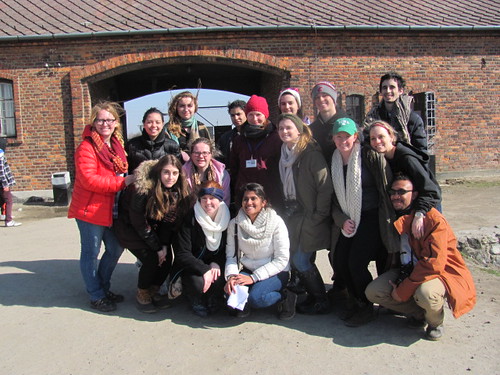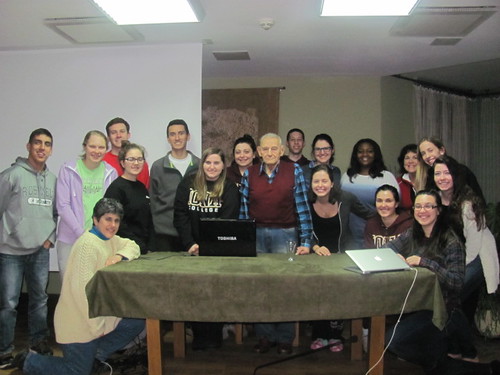 |
| Advertisement of “Der Ewige Jude” (The Eternal Jew), a 1940 antisemitic German Nazi propaganda film. This film was disguised as a documentary.
|
It has been one week since I last stepped on the grounds of Auschwitz I. Since my return from Poland, I have found myself especially sensitive to the use of words and phrases in everyday conversation, political discussion, and broadcast outlets. This stems from my shock at the absolute power of words- in forming an ideology, swaying a culture, and facilitating the genocide of millions of people.
In writing this, an old saying comes to mind: “Sticks and stones may break my bones, but words will never hurt me!” I can recall hearing this phrase throughout my childhood. Though it may have proved true in playground interactions, this phrase could not be further from the truth when one considers the impact of words, especially propaganda-fueled, in furthering the harm of the Jews and other groups.
In considering the power of words, one should start with the impetus of the Third Reich and Nazi Party- Adolf Hitler. Hitler was unabashed in his hatred for the Jewish people; in his first written comment on the “Jewish Question,” he asserts that the presence of Jews in any community was a “race-tuberculosis of the peoples.” (Source: US Holocaust Museum) His initial comments, released in 1919, are emulated in his further written and oral statements. In 1933, Hitler produced his first speech broadcasted live on all German radio stations. In this broadcast, he proposes a resolution to the “Jewish problem”- total annihilation of all European Jews, through a world war. (Source: BBC)
 |
| Propaganda poster labeling the Jew as “a people of contagion!” This poster mirrors the content of Hitler’s 1919 written comments.
|
Throughout our visits to Auschwitz I and Auschwitz-Birkenau, our tour guide Lidia further stressed the impact of words on disseminating Nazi ideology. She brought to our attention the establishment of Hitler Youth in indoctrinating German children, the use of propaganda by Joseph Goebbels and other prominent figures within the Third Reich.
Before we embarked on our journey to Poland, our group visited the United States Holocaust Museum in Manhattan, New York City. Here, we encountered a variety of propaganda pieces used to spread anti-Semitism and anti-Jewish sentiment. Most notable were a row of posters depicting the Jewish people as disgusting, leering, and money-hungry monsters. These images cemented in the minds of German society the notion that Jews were nothing more than parasites and a stain on the face of Aryan purity.
 |
| Antisemitic propaganda released in Poland in 1941. This poster depicts the Jew as a parasite, likened to that of typhus.
|
The influence of propaganda, and words as a whole, was made evident in the words and behavior of Nazi officers and even German civilians. Alexander Donat’s memoir
The Holocaust Kingdom makes tangible the power of words, as he recounts the usage and power of words in promoting hatred and harm.
In the initial liquidations of the Warsaw ghetto, Donat recalls the phrasing that Ukranian guards and German troops used to force people from their apartments: “
Alles runter!” – In English, “Everything downstairs!” Donat notes that “the tone was bad enough, but the humiliating impersonality of that ‘everything’ where normal speech called for ‘everyone’ was even more shocking.” (The Holocaust Kingdom 56) This shift in language illustrates the shift in thought of Germans and Ukranians towards their fellow humans, and the dehumanization of Jews.
Other insults hurled at Jews included: “
Schweinehund [pig dog],” “
Dreckjude [shitty Jew],” “whore,” and “
Judenschmarotzer [Jew parasite].” Donat emphasized that “obscenities were used so abundantly at Majdanek that often you did not hear a decent word for hours on end.” (173)
And what resulted from these words? In my eyes, these words ushered in a disregard for human life that did not fit the “Aryan mold." German officers treated Jewish prisoners like their insults, and in reducing them to “parasites,” viewed their lives “as essentially worthless; in fact, contemptible.” (Donat 176) The SS soldiers delighted in ousting these “subhuman” Jews, inventing new methods of torture and indulging in the “fear and the death agonies of the victims.” (Donat 173) Beyond the torture and death of millions of Jews, the words of the Third Reich held the German people in an “iron grip; they followed orders and kept their mouths shut, they submitted…” (Donat 233) With overwhelming control and sadism, the Nazis destroyed the lives of many, even as the Third Reich began to collapse. How devastating words were, in facilitating the breaking of spirits and bones of so many innocent lives.
Just yesterday, it was announced that a Holocaust denier will be the GOP’s nominee in a Chicago congressional district after running in a primary election. Candidate Arthur Jones is an outspoken Holocaust denier; his candidacy website contains pages of documentation “disproving” the Holocaust and dismissing the death of millions of Jews. Phrases from his website are eerily similar to the aforementioned propaganda of the Third Reich:
"The ‘Holocaust’ is quite a racket. Millions of dollars are made each year by the Jews telling this
tall tale…
Elie Wiesel [Holocaust survivor] is simply a
skillful liar…
[Survivor accounts of the Holocaust are] propaganda, whose purpose is designed to
bleed, blackmail, extort and terrorize, the enemies of organized world Jewry…
Their ‘Holocaust’ [is] just an
extortion racket.
"
I have been made furious to learn of this news and to read these documents, and have thought-
What can I do now, with what I know? How can I, and others like me, best combat this utterly false information?
As mentioned previously, words can be used to generate destructive power. I recognize that my words need to be used to generate informative, educational, and defense of those who have suffered. This is certainly, in many ways, a power worth reckoning.

















































